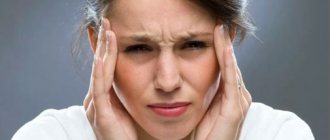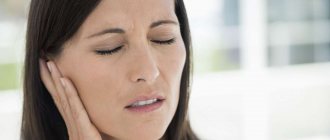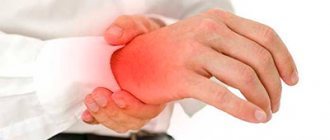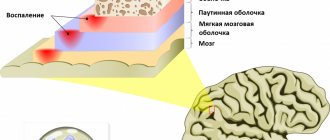Pain above the eyebrows - causes
Trigeminal neuralgia
Trigeminal neuralgia is a condition that causes sharp, intense pain in the facial area. The trigeminal nerve connects the brain to the face, allowing a person to sense touch and changes in temperature.
Trigeminal neuralgia usually affects only one side of the face, but in rare cases it can affect both sides.
Some people with this condition may experience stabbing pain that feels like an electric shock. Others may have constant pain and burning in the facial area.
Secondary pain above the eye
Let's look at the main reasons why the eyebrow above the eye, eyebrow, eyelid and forehead hurts:
What is accommodative asthenopia
- hormonal imbalance. Attacks of severe pain can occur during puberty, menopause, before menstruation, and during pregnancy. Female hormones affect the elasticity of blood vessels, which leads to unpleasant sensations;
- unsuccessful plastic surgery to eliminate wrinkles;
- trigeminal neuralgia. Although neuralgia affects the left eyebrow, the right one can also hurt, since the processes of the trigeminal nerve go to it. Patients complain of excruciating pain that radiates to various parts of the face;
- With intracranial pressure, objects appear in two before the eyes, and dark circles appear before the eyes. The cause of this condition is a violation of the microcirculation of cerebrospinal fluid or its excessive formation. The condition manifests itself in the form of general weakness and drowsiness. Injuries and neoplasms can lead to increased intracranial pressure;
- neoplasm. An accurate diagnosis can indicate the presence of a tumor;
- traumatic brain injuries.
Trigeminal neuralgia is one of the causes of pain above the eye
Cluster headache
A cluster headache is a severe headache that can occur one to eight times a day and last from 15 minutes to 3 hours each time.
People may experience stabbing pain, often either behind the eyebrow and eye, or around the temples. This pain and other symptoms usually affect one side of the head.
Cluster headache symptoms
- red, watery eyes;
- runny nose;
- flushed face;
- drooping eyelid;
- hyperkinesis;
- inability to lie still.
Shingles
Shingles is a condition that affects the nerves. It occurs in localized areas, usually on one side. These areas may include the face and neck.
Symptoms of herpes zoster
- a painful, fluid-filled rash;
- shooting pain;
- tingling or numbness sensation;
- burning;
- itching;
- fever and chills;
- nausea;
- headache;
- loss of vision.
People should see a doctor immediately if they notice blisters on their face, especially if they are close to the eyes.
Sinusitis
Sinusitis is an inflammation of the sinuses. This can put a lot of pressure on the facial area and people may feel pain around the eyebrows, nose, forehead and cheeks.
Symptoms of sinusitis
- stuffy nose;
- cough;
- thick, yellow or green mucus from the nose;
- mucus running down the throat.
Sinusitis can be either acute or chronic. Symptoms of acute sinusitis usually resolve within a week or 10 days. If symptoms do not improve with treatment and last longer than 12 weeks, a person may develop chronic sinusitis.
Treatment with unconventional methods
In some cases, when it is difficult to endure discomfort, and it is not possible to consult a specialist at the moment, you can turn to traditional medicine methods. Such remedies may well be in your home medicine cabinet; they are medicinal herbs that are not difficult to purchase at any pharmacy.
Folk remedies for relieving eyebrow pain:
- apply a cold compress, wrapping ice cubes in a towel, a bag of frozen vegetables (it must be periodically removed from the forehead for a couple of minutes to prevent hypothermia);
- make herbal compresses, for example, from brewed coltsfoot herb;
- consume the following infusions internally: potato juice, valerian, lingonberry, nettle, viburnum with honey, mint, propolis;
- Apply a soothing mixture containing 2 parts of motherwort, the same amount of mint, and one part of thyme.
These folk recipes can be effective when the cause of the problem is overexertion of any kind. If the unpleasant sensations do not go away for a long time and are very disturbing, you cannot delay contacting a specialist who will definitely conduct the necessary examinations, establish a diagnosis and prescribe adequate therapy.
Temporal arteritis
Giant cell arteritis, or temporal arteritis, is a condition that affects the blood vessels along the side of the head.
Inflammation of these blood vessels can cause facial pain and other symptoms such as:
- jaw pain;
- temporary loss of vision;
- fever;
- severe headaches;
- dizziness;
- difficulty swallowing or sore throat.
According to the Arthritis Foundation, people over 50, especially women, are more likely to develop giant cell arteritis.
Treatment and home remedies
Treatment for eyebrow pain depends on the cause:
- Headaches and migraines: Painkillers, as well as more rest and sleep, may help.
- Severe or frequent migraine episodes: Your doctor may prescribe pain medications.
- Cluster headaches: Your doctor may recommend pain medications or an oxygen mask to prevent a cluster headache.
- Shingles: Rest, a cool compress, and calamine lotion can help soothe the symptoms of shingles until the infection clears up.
- Glaucoma: Taking eye drops daily may help prevent vision loss in people with glaucoma. Beta blockers and alpha agonists also help reduce fluid buildup in the eye.
- Sinusitis: Patients can take anti-inflammatory medications and nasal sprays to treat sinusitis. Pain medications, adequate rest, and proper hydration may also help reduce symptoms.
- Trigeminal neuralgia: Your doctor may prescribe medications or recommend surgery.
- Giant cell arteritis: Corticosteroids can effectively treat the symptoms of giant cell arteritis.
Useful tips
So, what to do if your eyebrow hurts :
- Do a light, unobtrusive massage every day: stroke your head from the forehead to the back of the head;
- relax more in the fresh air;
- arrange warm foot baths at night;
- increase the amount of fluid consumed;
- maintain a sleep-wake schedule;
- give yourself vitamin therapy twice a year;
- try not to be nervous and not worry about trifles;
- perform facial exercises daily;
- you can even try animal therapy: pain in the eyebrows is relieved by cats, whose purring starts the healing process and absorbs negative energy.
If the cause of pain in the eyebrow is its injury, it will be useful to take the following measures:
- in case of a closed injury, apply a towel soaked in cold water and an ice pack to the eyebrow;
- in case of an open injury, stop the bleeding, treat the edges of the wound with hydrogen peroxide, iodine;
- call an ambulance.
If your eyebrow hurts, do not tolerate these unpleasant sensations. Even painkillers and folk remedies only work for a while. At the first suspicious symptoms, go to the hospital, get examined and, strictly following the doctors’ recommendations, get treatment.
When to see a doctor?
A person should see a doctor if eyebrow pain is severe, persistent, or accompanied by other symptoms.
People with eyebrow pain should seek immediate medical attention if they also have the following symptoms:
- severe pain or swelling of the face;
- swelling or redness around the eyes;
- confusion or feelings of disorientation;
- sudden severe headache;
- drowsiness;
- fever;
- rash;
- nausea and vomiting.
People should see a doctor if they have symptoms of any of the following conditions:
- shingles;
- giant cell arteritis;
- severe or frequent migraine episodes;
- trigeminal neuralgia;
- glaucoma.
Probable causes of the phenomenon
Why does my eyebrow hurt? There can be many reasons for this problem.
Very often, such a problem does not have dangerous preconditions, being only a violation of the correct lifestyle. The following factors may influence the appearance of unpleasant sensations:
- overvoltage;
- intoxication of the body;
- staying at the computer for a long time;
- abuse of unhealthy foods (spicy, salty, fried);
- high level of physical activity;
- prolonged mental stress.
Very often, discomfort is a consequence of cosmetic procedures. For example, tattooing, during which pigment is injected into microscopic incisions on the surface of the eyebrows. In addition to pain, swelling and redness may persist here.
If the procedure is performed incorrectly, discomfort may also occur. Very often this symptom occurs when the threads are inserted incorrectly.
We must not forget about injuries that do not necessarily accompany hematomas. Sometimes they can only manifest as pain.
Any pain is divided according to the nature of its manifestation:
- fascicular: here the unpleasant sensations attack, repeat every 20 minutes, lasting up to 3 hours;
- with impact in the teeth;
- discomfort from excessive tension;
- shingles, with general weakness, loss of appetite;
- migraine, where the pain is concentrated on the bridge of the nose, in the temples, and intensifies with loud sounds and bright light.
Diseases
Often the problem lies in the presence of certain diseases:
- sinusitis (inflammation of the sinuses, their expansion or contraction, the main symptom here is a prolonged runny nose);
- frontal sinusitis;
- osteochondrosis;
- diseases of the central nervous system;
- flu;
- ARVI;
- increased intracranial pressure;
- meningitis, encephalitis (dangerous diseases that can only be diagnosed by specialists through examination and certain tests): here, pain is localized in a certain area, body temperature changes;
- inflammation of the trigeminal nerve (only a neurologist can help in diagnosing the disease);
- intracranial pressure;
- brain tumors;
- colds, viruses, other infections (here it is especially important not to delay so as to prevent the development of rather dangerous complications).
We recommend reading: Why is there no color after eyebrow tattooing?
Lifestyle
Unpleasant sensations that arise in the area of the brow ridges are not always symptoms of the presence of dangerous or not so dangerous diseases. They can also occur in absolutely healthy people, being a sign that the chosen lifestyle is not correct.
Pain occurs when:
- frequent smoking, due to sagging blood vessels that spasm;
- alcohol intoxication;
- frequent consumption of spicy, fatty foods, which negatively affect the condition of the vascular walls;
- physical fatigue;
- working at a computer screen for a long time.
Cosmetic procedures
Often the problem develops after cosmetic procedures:
- tattooing (unpleasant sensations disappear within a few days);
- performed not according to the rules of plastic surgery of the brow ridges and other areas around the eyes;
- allergic reaction to used cosmetics.
In order not to waste precious time that may be needed to treat diseases, this symptom should not be ignored, even if it seems completely harmless. It is imperative to seek medical help so as not to miss the development of dangerous brain damage.
Summary
People may experience eyebrow pain for many reasons. Sinusitis or headaches can lead to increased pressure and pain in the eyebrow area, which should go away as soon as the cause is eliminated. Other times, eyebrow pain is due to an underlying condition such as glaucoma.
If people experience frequent or severe pain around the eyebrows or notice other symptoms, they should consult a doctor immediately.
Another article on the topic: Drinking small amounts of caffeine every day does not cause migraines.
Drug therapy
Treatment of a particular disease is prescribed in strict accordance with the diagnosis that was made to the patient. This could be a recommendation to reduce the rhythm of life, limit work at the computer, or take antibacterial agents.
In particularly advanced cases, for example, with sinusitis, surgical intervention may be indicated.
NSAIDs
Nonsteroidal anti-inflammatory drugs are a group of drugs that are used to provide first aid to patients suffering from pain of unknown etiology. These drugs simultaneously have analgesic and minor anti-inflammatory effects.
NSAIDs include medications containing the following substances:
- metamizole sodium;
- acetylsalicylic acid;
- paracetamol;
- ibuprofen;
- nimesulide.
Non-steroidal anti-inflammatory drugs include:
- Analgin;
- Aspirin;
- Nurofen;
- Paracetamol;
- Nise, Dolgit.
The drugs are characterized by a small number of side effects, as well as a pronounced analgesic effect. If you take tablets to relieve spasms together with them, you can quickly get rid of pain associated with narrowing of the vascular walls.
We recommend reading: What determines beard growth?
Caffeinated products
If there are disturbances in the normal functioning of blood vessels, it can be difficult to do without the use of caffeine-containing products. These are complex preparations that simultaneously contain several components:
- Tetralgin;
- Pentalgin;
- Citramon.
Every person taking such medications must understand that their use is a temporary measure to relieve acute manifestations of the disease. After symptoms are relieved, if they still recur periodically, you should definitely seek help from a doctor in order to establish the correct diagnosis and prescribe adequate therapy.
Sedatives
The use of sedatives is indicated in the presence of pain caused by excessive nervous tension, constant exposure to stressful situations, and a large amount of physical and mental activity.
Sedative medications should be prescribed by a doctor only if there are strict indications, with a carefully selected dosage regimen.
Taking such drugs at your own discretion, without medical supervision, is strictly prohibited.
Sedatives
In order to calm the nervous system, a specialist may prescribe the patient to take sedative medications. They relieve a person of stress, which is most often the cause of unpleasant sensations in the bridge of the nose.
Experts recommend taking the following medications:
- Afobazole;
- Phenibut;
- Novo-Passit;
- Persen;
- Sanason-Lek.







